You are reading the older HTML site
Positive Feedback ISSUE
may/june 2007
Audio Ramblings - Further thoughts on the EMM
CDSA SE, along with notes on the Furutech Nano contact enhancer, Audio Magic
Clairvoyant Special Edition cables, and the
Clayton M200 amplifiers
by Dave Clark
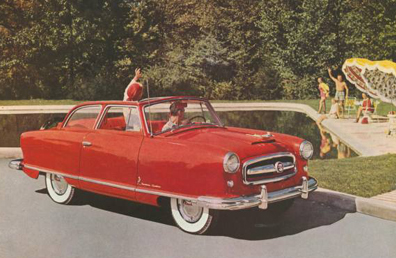
There are several items I feel a need to ramble on and on and on here for a bit. A new audio treatment from Furutech, a revised and new cable from Audio Magic, and an initial take on the new and improved Clayton Audio amplifier (a more in-depth review on both items will appear soon).
But first off in reading my EMM CDSA SE review I realized that a comment or two might leave the reader with a misunderstanding of sorts. In the review, I mentioned that the EMM adds an ever so slight grit or grain to female vocals—okay vocals in general and some degree that grit/grain or digital presence can be heard on most Redbook discs. But it is never to the degree that makes the player to not be a solid recommendation or stellar digital playback option. What occurred to me is that what I might be hearing is perhaps nothing more than the CDSA SE allowing for Redbook (16/44.1) to reveal the distortion/noise that is inherent in many CDs.
Now I am not a digital know-it-all, so if this is a big bunch of hooey, well… then I have been fed a big bunch of hooey. But in talking to a couple of people who should know the skinny as to why upsampling can make certain discs sound grainy, gritty, or harder and brighter when compared to discs upsampled to a lesser frequency or those played back at 16/44.1 …well this is what they fed me. So drag them through the fire. I am only the messenger here and as such, I am attempting to make sense of why I heard what I heard on either player by asking around. What these digital audio braniacs tell me is that the upsampling allows the noise and crap that is usually cut off by normal filters at 22 kHz to now pass on to the listener. This distortion/noise is not readily audible when a 16/44.1 disc is played back on a standard machine (one that does not upsample), but is audible on a player starting from 96 kHz and up to whatever. The noise exists beyond the cut-off of 22 kHz and is a left over from the act of turning analog into bits due to a poor understanding (and no doubt to use of inferior technology) of how best to work with the digital medium. Each disc/recording will have more or less noise or distortion than another based on the recording process. This is then revealed or produced as whatnot by the player as good or bad crap. Some may find this noise/distortion (or crap) good or bad—and since many an audiophile, depending on who you ask, find upsampling to be good and many others not so good …well there you go.
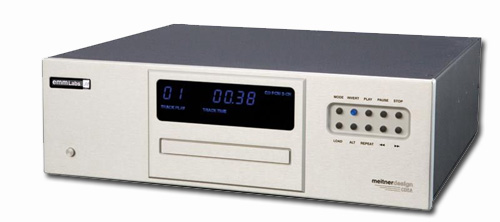
As I said, no doubt how the CD player handles this noise is also an issue. In listening to the EMM with its sampling out to 5.6448MHz, along with its incredible linearity, it seems that the crap is laid out for all to either appreciate or not. Same for the Cary, though not to such an extreme. It only goes out to 768 kHz and since it has more color or seasoning than the EMM, the crap is less noticeable. In playing back discs at 768 kHz on the Cary, I have noticed that they take on too much of an edge or digital presence—should we make that grain and grit? Sort of what I hear on the EMM, though in a different way. Which is not to suggest that the EMM does the noise better or worse, it just does the noise differently based on its overall character and the fact that is does not cut off Rebook till 5.6448MHz. On the Cary the 512 kHz setting seems to be better to my ears, though some here like it at 44.1 kHz or 192 kHz …gee go figure.
So the EMM is not at fault here. It is just passing along what is on the disc, and one hears this—good or bad—all framed within how the EMM sounds overall, its character. Of which, like I said in the review, reminds me of the best in solid-state: fast, dynamic, slam, visceral, clean, linear, and well ...honest. The same applies to the Cary, though it presents itself as being the best one can hear from tubes (though it has none—it just has a sense of that sonic quality): color, warm, robust, 3-D, palpable, clean, and well ...honest. Either player is a winner.
At my request, Furutech sent me their Nano contact ($99) treatment fluid stuff to try out. Being a proponent of getting the best contact one can between any surface to minimize noise and maximize transfer of whatever (AC or signal), their stuff seemed like an interesting approach to this area of audio tweakdom.
To quote form the Furutech site:
...Nano Liquid’s molecules are so tiny (8 nano-meters in diameter (8/1000000mm) they “fill up" any air bubble holes left during the plating process when brushed onto connectors.
…Squalene Oil can remove oxide and other debris etc. from the surface of metal, making the surface clean and free of pollution, thus activating the metal surface.
...applying the principle of atomic adsorption, Furutech uses gold & silver super-micro particles, adhering to metal surface evenly, they fill in any concave-convex sections on surface, increasing the electric conduction area and debasing impedance (Ω).
…this very stable liquid (Squalene Oil) forms a layer protective film on the surface of the metal, preventing oxidation. Utilizing the oils excellent adsorption properties gold & silver super-micro particles evenly adhere to surface of the metal.
Squalene Oil is sourced from olives, palm oil, and wheat germ oil. However, the largest concentration of Squalene Oil is from the liver of deep sea sharks caught for commercial fishing. Now if this a good or bad thing I am not sure of …though I do like sushi. As to the conductivity of Squalene Oil used as a suspension for the gold and silver micro-particles used in the Nano fluid, well not so sure of that, but it does conduct electricity or at the very least an audio signal and does it quite well.
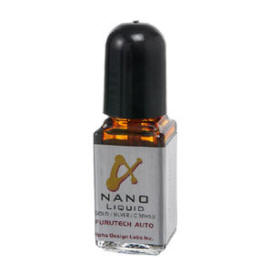 It is rather easy to apply, but the Squalene Oil
will stain your skin and clothing, so beware—the bottle is quite small as is
the brush, so one needs to be careful and not spill. The application brush
applies a very thin amount to the chosen contact surface (having so far only
tried it on speaker connections) making for quick and easy work. I did clean the
contact with Caig ProGold and followed with a good a rinse or two of alcohol to
remove any residue. That way, the Nano was seeing a clean nude surface and not
whatever was on the connectors that might interfere with what I was about to
hear.
It is rather easy to apply, but the Squalene Oil
will stain your skin and clothing, so beware—the bottle is quite small as is
the brush, so one needs to be careful and not spill. The application brush
applies a very thin amount to the chosen contact surface (having so far only
tried it on speaker connections) making for quick and easy work. I did clean the
contact with Caig ProGold and followed with a good a rinse or two of alcohol to
remove any residue. That way, the Nano was seeing a clean nude surface and not
whatever was on the connectors that might interfere with what I was about to
hear.
So listen with the contacts cleaned… that’s nice …and then with the Nano applied… Ahhh …nicer still.
Audible the improvements were in areas of dimensionality, dynamics, and the sonic tapestry taking on a more texturally vivid presence. Especially noteworthy was a greater sense of bass impact, along with everything becoming that much more visceral and alive. Not a dramatic “My jaw hit the floor" sort of thing, but simply put the music sounded better. Smoother with a more organic feel, while still taking the overall resolution up a notch. A sure recommendation to try without any issues in terms of longevity—been a month now and the contacts look clean and healthy. Word has it that the stuff holds up very well even after a year or so. But even if it does age, the silver will tarnish making for even better conductivity between the two surfaces. As for the gold, well it stays nice as it is—no tarnish. I am assuming that the two metals, along with the Squalene Oil, may be the factors behind the smoother and more organic feel… with the improvement in contact/conductivity allowing for the rest of what I hear.
Furutech also sent me their new Electrostatic Brush. The brush is claimed to remove static electricity that builds up on CDs and LPs. Furutech says that… “Microfiber squares actually charge LP and disc media during cleaning! That's on top of the static charge generated from removing media from its protective cases or cover. CDs develop somewhere around 500~1,500V of "frictional static electricity".
The brush removes the charge rendering the surface static free. How this affects the sound, I am unable to say as I have yet to try it, though it does sound interesting… next column.
In talking to the silver-man, Jerry Ramsey of
Audio-Magic, he informed me that he had reworked my Clairvoyant 4D cables with a
different geometry, as well as making some upgrades that transformed the cable
to another planetary experience. Needing them re-terminated (RCA to XLR) to work
with my shift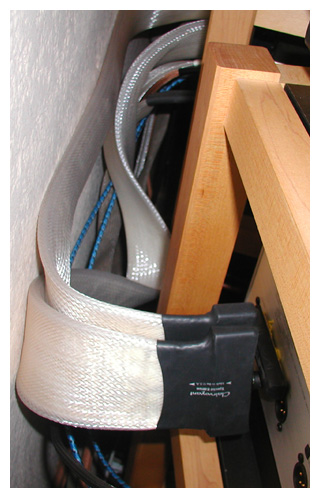 to a all balanced system (based on the balanced designs of the
Claytons, the Cary SLP-05 preamp, and the Cary 306 and EMM CDSA SE CD players)…
off they went. What Jerry is doing adding another conductor made from silver and
gold particles with the result being that the cables are damn scary good. Way,
way more dimensional and musical than ever before… and before they were pretty
phucking amazing. No silver edge or hardness, a rich and natural
tonality, resolution and presence that is so amazingly right, a soundstage that
goes out the door and around the block… gee you think I might like them!?
Anyhow, the new Clairvoyant 4D are here for the long haul and since I am just
getting a handle on what they bring to the table… more to come. But for now
consider them one of the best around.
to a all balanced system (based on the balanced designs of the
Claytons, the Cary SLP-05 preamp, and the Cary 306 and EMM CDSA SE CD players)…
off they went. What Jerry is doing adding another conductor made from silver and
gold particles with the result being that the cables are damn scary good. Way,
way more dimensional and musical than ever before… and before they were pretty
phucking amazing. No silver edge or hardness, a rich and natural
tonality, resolution and presence that is so amazingly right, a soundstage that
goes out the door and around the block… gee you think I might like them!?
Anyhow, the new Clairvoyant 4D are here for the long haul and since I am just
getting a handle on what they bring to the table… more to come. But for now
consider them one of the best around.
Jerry also sent me a finished proto-type of his latest and greatest AC cord, the Clairvoyant Special Edition (the picture to the right shows the Clairvoyant Special Edition interconnect—so take these, make them suitable for AC by adding the Oyaide plugs along with the rest as outlined next). This cord is not for the faint of heart as it measures 3" wide and a good 1" deep and is simply gorgeous at making my system sound quite wonderful. Looking like a hyped up version of the Clairvoyant 4D speaker cables, but weighing a good bit more, the cable features 3" copper, silver, gold particle conductors, Quantum Physics Noise Disruptor material, PL-7 dielectric, a sliver ground, and Oyaide P-079 and C-079 plugs. Double cryo’ed and MST treated, the cord retails for $3000 per 1.5 meter.
Since I only had one and it weighs a bit too much to hang off my CD players, I tacked it onto the Cary SLP-05 preamp. The results were not what one would expect going from a copper AC cord to one made primarily from silver. The system took on a greater sense of relaxation, while upping the resolution and jump factor by several degrees. More information, more dimensional magic, more music. A true killer in AC cords, this is the one you have got to hear if you are into $3k AC cords. Let me conclude in how I had recently had a couple of audio buddies over to hear the changes in the system. One of them mentioned that while he thought the system had always sounded quite good, it had never got him all that into the music, sort of leaving him out of the fun. With the Cary SLP-05 preamp seeing its AC via the Clairvoyant Special Edition, he now found the system to be so beguiling that he had a rather difficult time leaving later that day. I was told that all he could do on the way home was talk about how the system sounded sooooooo much better in everyway! He went on as to how the Clairvoyant Special Edition was amazing in how it transported a very good system into something truly beyond what he had expected. Anyhow, more to come!
Clayton Audio is a St. Louis based company dedicated to producing reference quality amplification for those who value the palpability and elegance of natural, live sound. Making only class-A amplifiers of reference quality, they are the creation of Wilson Shen, a retired IBM engineer who specialized in analog circuit and power supply designs and who wanted to bring some of his expertise to the field of audio. While the new amplifiers run hot, the power supplies are built to a standard with temperature tolerances that allows them to last way past my time. Yeah, they run hot, the new $9500 a pair M200s are rated at 200-watts @ 8 ohms and 400-watts @ 4 ohms… meaning that they make heat, serious heat. The older M100s offered a low bias setting to cut the heat factor, but the new beasts dropped this feature in the pursuit of sonic nirvana. So while they are not the best thing in a world facing global issues, and since I only turn them on when I want to listen (and make every effort to turn off a bunch of lights), I think I may be ahead here since I used to leave the M100s on 24/7—which spun the meter rather well.
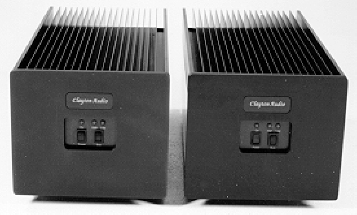
Anyhow they look a lot just like the older M100s (to the left), but feature balanced in only (no RCA option)… and like I said they lost the low bias setting. Other than that, and a new transformer and various parts, you get the Clayton sound, though several times better. The M200s are more open, have less of that solid-state darkness, a deeper faster better bass with greater tactilityness, more dimensional palpability, and well… they sound so nice and musical that I had to buy them. Wilson truly makes one the best solid-state amplifiers in the world. I have had many other amplifiers here for review, and every time the M100s came out as the preferred choice—yes the rest were very good, but the Claytons are something truly special. The new amps move well beyond the older versions by addressing any shortcomings and then pushing their positives up several notches. No solid-state edge or grain, they sound very nice indeed. More to come.
